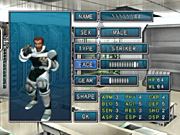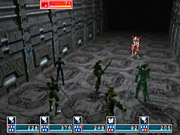Metal Dungeon is a dungeon-crawling game originally developed in Japan by Panther Software. As an RPG more in the vein of Grandia Xtreme than Final Fantasy, it stands out from the traditional console RPGs and should be a welcome change. Regrettably, its lack of content and lackluster design take away much more than its relatively unique mechanics add. Overall, it's an experience that redefines the word "bland."

The premise of the game involves simply clearing out the titular dungeon. The regions of the futuristic world of Alansas have been at war for a long time, and the most powerful weapons are "weapon monsters," a mishmash of cybernetic beasts and humanoids. The Giamel region, fighting a losing battle, makes a last-ditch effort to create weapon monsters by capturing powerful sorcerers. The sorcerers are put into a trance deep within an underground facility, and production begins. However, the scientists aren't able to control the sorcerers and soon the monsters have taken over the facility. If the sorcerers manage to recover fully from their trances, the weapon monsters will break out uncontrolled, and it will be the end of Giamel. As all of Giamel's forces are engaged in battle, mercenaries are called on to enter the facility and destroy the sorcerers.
You control a team of up to five mercenaries, whom you can create using a console rarity--a character generation system. However, what could have been a breath of fresh air turns out to be a little thin on oxygen. With five classes, and the ability to further advance into five more, there are plenty of character types, but apart from some differences in the trimming on the different classes' generic full-body armor, all the characters look nearly identical. While some nods are made to customization by allowing the player to select one of 24 heads, choose one of eight colors for armor, and adjust height and weight (weight is represented by a ridiculous-looking compacting or widening of the entire base character model), the only thing that gives the members of your party any sort of identity in game is the weapons they're holding.
Get used to those weapons. There are five types of weapons in the game--swords, hammers, knuckles, rods, and guns--and the more-powerful versions of each weapon look exactly the same as their weaker counterparts. The different guns can eventually have different visual effects when they're fired, but otherwise what you start with is what you finish with. The same goes for armor. In fact, unless you change a character's class, he or she will never be noticeably different in any way other than in stats. With character classes that aren't all that distinguishable to begin with, the static nature of the avatars as the game progresses further dilutes the visual impact of the game.
The biggest contributor to that featureless visual feeling, though, is the dungeon itself. "Metal dungeon" is an apt description, as there are no other distinguishing features. The 10 sections of the dungeon are all randomly generated, using a 3D tileset that has more in common with the periods and pound signs of the old text-based computer game Rogue than it does with the visual diversity of the Diablo series. The bulk of each section is laid out entirely from one wall tile, one floor tile, and one door tile. There are four or five special rooms, for things like elevators and control panels, but otherwise each relatively large level is completely devoid of any variety. Even the weapon monsters patrolling the level are all represented by a single model, a generically round thing that resembles a probe droid from Star Wars.

The only plausible reason that the actual monster models themselves don't roam the level is because they're only animated for idling, attacking, and being hit. Having the monsters patrol the levels would certainly have added the tiniest bit of variety to exploring, even if there weren't any animation. Still, the weapon monsters are seemingly the only part of the game that any sort of attention was given to at all. Metal Dungeon has more than 70 monsters--though some of them are merely palette-shifted versions of other monsters--and they all look pretty good compared with the rest of the graphics. Though, it's more of a less-dull spot than a bright spot, thanks to the rudimentary animation. Thankfully, the animation can be turned off to make the battles go more quickly, and the speed of the battles themselves is adjustable.
Fighting in Metal Dungeon is a real-time, party-on-one-side, monsters-on-the-other affair. A full party of five characters is organized into two rows, three in the front and two in the back. Those in the back row are safe from melee attacks. Each party member will default to attack, unless he or she is in the back row and isn't equipped with a gun, in which case that character will default to guarding. You can issue orders to characters that they'll execute when it's their turn, after which they go back to their default. The only real flaw in the combat is that issuing an order doesn't pause the action. The ability to alter the battle-speed setting and turn off the animations can be useful in alleviating tedium, but those options can't be changed during battle, and issuing an order can be somewhat time-consuming, leaving you at a disadvantage. Some people will be put off by not being able to target a specific enemy unless you constantly issue specific orders, trying to stay ahead of the real-time nature of the battle. The default of letting the characters target their attacks randomly won't really affect the outcome of a battle, though it is a bit exasperating seeing a character ignore a monster with just a few hit points left and attack one still at full, and then watching both of the monsters attack. While nothing about the combat is particularly awful, like the rest of the game, it just fails to be interesting, from the animations to the music, which sounds more like a Russian funeral march than a proper battle anthem.
Metal Dungeon is obviously a rushed game. Amazingly, there aren't any bugs or particularly rough edges in the gameplay mechanics, but Diablo II has set the bar for these types of games in terms of both polish and content, and this game doesn't even come close. While it's fairly well balanced where difficulty is concerned, and it has plenty of stats, classes, and inventory slots, none of these tried-and-true mechanics actually mean anything if the look and feel of what's happening onscreen doesn't distinguish itself, and it certainly doesn't in this case. There's just too little in terms of art content, and what little is there isn't even well executed. For all its 3D trappings, Metal Dungeon is a very basic game, one that would have the same feel if it were text-based and is certainly not worth paying full price for.